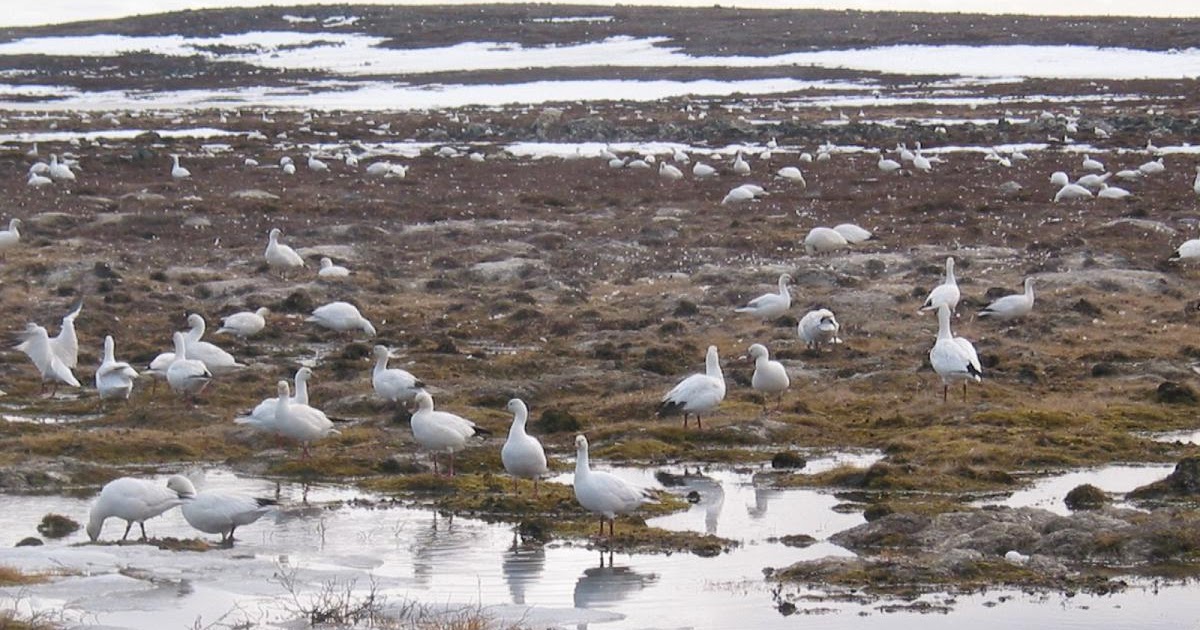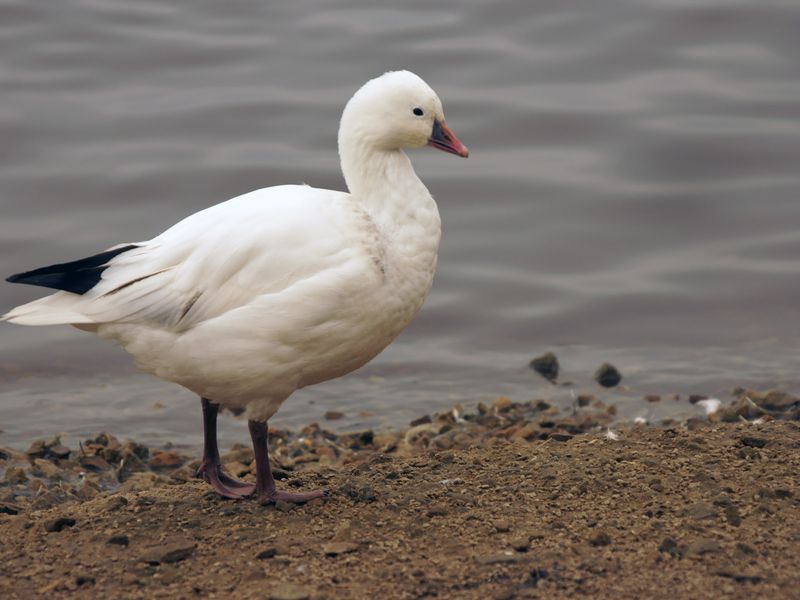
Queen Maud Gulf Migratory Bird Sanctuary, Nunavut. Shown are the extent
Queen Maud Gulf (Ahiak) Migratory Bird Sanctuary (MBS) is in Nunavut. The 6,292,818 hectare MBS is located on the continental lands located south-est of Victoria Island. It was established in 1961 originally to protect the largest variety of geese found in any nesting area in North America.

Queen Maud Gulf Migratory Bird Sanctuary, Nunavut. Shown are the extent
The Queen Maud Gulf Bird Sanctuary is nearly 63,000 square km. Becoming a protected area in 1961, it is a sanctuary for a broad range of migratory birds, including plovers, ducks, geese, loons, sandpipers, gulls, Arctic terns, Jaegers, sparrows, hawks, falcons, swans and snowy owls. A permit is required to access the sanctuary.

Canada’s Boreal Forests — Now Cold, Dark, And In Need Of Our Care
Qamanirjuaq herd Ahiak herd The Ahiak caribou calve in the vicinity of the Adelaide Peninsula (eastern Queen Maud Gulf) east to Pelly Bay, Nunavut. The herd spends most summers in the Queen Maud Gulf Migratory Bird Sanctuary.

Queen Maud Land in Antarctica looks so otherworldly, it would have been
North America Nunavut Save Across the Queen Maud Gulf from Gjoa Haven, the tundra and shallow lakes that make up this sanctuary are home to one the world's largest concentration of nesting geese. Organise a trip through your lodgings or with the hamlet office. Suggest an edit to this attraction

The Ahiak Queen Maud Gulf Migratory Bird Sanctuary YouTube
Established in 1961, the Ahiak (Queen Maud Gulf) Migratory Bird Sanctuary (MBS; Ahiak MBS) covers 62,920 square kilometers of contiguous land and sea making it the largest protected area in Canada. Located on Nunavut's central mainland coast, this expansive track of intact natural land is the only MBS

Location of the Karrak Lake ecosystem in the Queen Maud Migratory Bird
The herd spends most summers in the Queen Maud Gulf Migratory Bird Sanctuary. The herd winters on the barrens and in the boreal forest in the area northwest of the Saskatchewan border to the north side of Great Slave Lake. The Ahiak herd overlaps with the Bathurst caribou herd on the west and the Qamanirjuaq and Beverly herds to the east.

The Karrak Lake ecosystem within the Queen Maud Gulf Migratory Bird
This migratory bird sanctuary is Canada's largest federally protected nature preserve. It is home to one of the greatest concentrations of nesting geese on Earth. The landscape has countless shallow lakes and huge expanses of arctic lowland. More information: Queen Maud Gulf Migratory Bird Sanctuary

An Aerial View Of The Queen Maud Photograph by Gordon Wiltsie
Queen Maud Gulf. 24/05/82; Northwest Territories; 6,278,200 ha; 67°00'N 102°00'W. Migratory Bird Sanctuary. Canada's largest Ramsar site embraces a vast tundra plain comprising a huge area of low-lying wet sedge meadows and marsh tundra, interspersed with communities of lichens, mosses and vascular plants.

Principales Humedales del beQbe
Queen Maud Gulf Migratory Bird Sanctuary, Northwest Territories Queen Maud Gulf (Ahiak) Migratory Bird Sanctuary, NT (Photo by Jennie Rausch/Envrionment Canada) Area: 5,637,484 ha Established: 1961. Canada's largest protected area is a little known migratory bird sanctuary established to protect one of North America's most important areas.

(PDF) Land cover mapping of Queen Maud Gulf Migratory Bird Sanctuary
The Queen Maud Gulf ( Ahiak) Migratory Bird Sanctuary (MBS) is located south-west of Victoria Island, in Nunavut. It protects quality habitat for many birds, including geese, brants and swans. On this page Importance of the sanctuary: migratory birds and other wildlife Landscape Map of the area Access to the sanctuary Key facts Related link

World's Largest National Parks The Top 15 Parks By Size ⛰️
The Queen Maud Gulf Migratory Bird Sanctuary, Canada's largest, was established in 1961 to protect what were then the only known nesting grounds of Ross' Geese, and the nesting/feeding grounds for the largest variety of geese in any single area in North America.

Queen Maud Gulf (Ahiak) Migratory Bird Sanctuary Canada.ca
ᐅᒡᔪᓕᒃ (Queen Maud Gulf) (ᐊᕼᐃᐊᒃ) ᐅᑎᖅᑕᐸᒃᑐᓄᑦ ᑎᖕᒥᐊᓄᑦ ᓴᐳᔾᔭᐅᓯᒪᕕᒃ ᓄᓇᕗᑦᒦᑐᖅ. ᑖᓇ 6,292,818 hectare ᒥᒃ ᐊᖏᓂᓕᒃ ᐅᑎᖅᑕᐸᒃᑐᓄᑦ ᑎᖕᒥᐊᓄᑦ ᓴᐳᔾᔭᐅᓯᒪᕕᒃ ᐅᕙᓃᑐᖅ ᓄᓇᒥ ᐅᕙᓂ ᓂᒋᖅᐸᓯᐊᓂ−ᑲᓇᒃᓇᖅᐸᓯᐊᓂ ᕕᒃᑑᕆᔭ (Victoria−.

Wildbirds Broadcasting Queen Maud Gulf Bird Sanctuary an Important
Queen Maud Gulf Migratory Bird Sanctuary is the largest protected area in Canada, extending over land and sea. Established in 1961, this sanctuary was originally created to protect the largest variety of geese in North America, over 90% of the world's population of Ross' eese and 8% of Canada's population of snow geese.

Queen Maud Land, Antarctica, Photos National Geographic
Gjoa Haven - 07 Jan -23° -29° Overcast Clouds -29° Mon Tue Wed Thu History The native people of Gjoa Haven are Netsilingmiut ('people of the place where there is seal'). The Netsilik Inuit are direct descendants of the ancient Thule people and they have lived in the area around Gjoa Haven, Taloyoak and Kugaaruk for over a thousand years.

Queen Maud Gulf Migratory Bird Sanctuary, Nunavut 8 Figure 2
The Upper Canada Migratory Bird Sanctuary (MBS) is located along the St. Lawrence River 30 km upstream of Cornwall, and extends offshore to the international border. The site is managed by the St. Lawrence Parks Commission and the Province of Ontario. It includes the Crysler Farm Battlefield Park, Upper Canada Village, a marina, an airfield, a golf course, nature trails, and camping and picnic.

Queen Maud Gulf Polartours
The Queen Maud Gulf Migratory Bird Sanctuary is Canada's largest federally owned protected area, encompassing some 61,765 km 2 (23,848 sq mi) of the Arctic Circle coastline. 6,710 km 2 (2,590 sq mi) are marine, and 55,055 km 2 (21,257 sq mi) are terrestrial. [2]